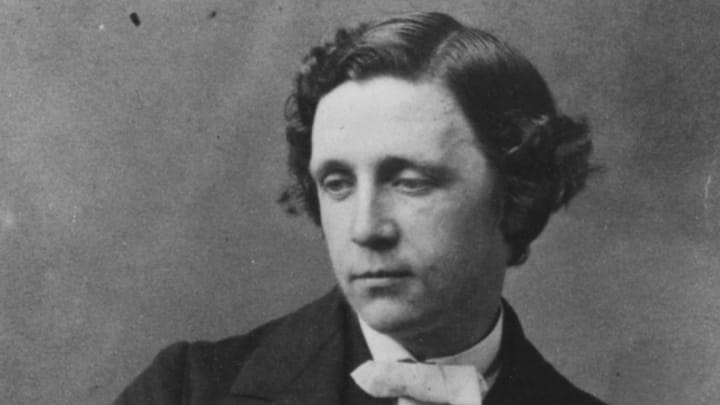Letting venerated children’s author Charles Lutwidge Dodgson rest in peace would appear to be a foregone conclusion. The author of Alice's Adventures in Wonderland and several ancillary titles, Dodgson—who was better known for his work under the pen name Lewis Carroll—projected a quiet presence, toiling away as a lifelong bachelor and Oxford math teacher until his death in 1898.
Perhaps it was Carroll’s genteel persona that invited some scandalous theories about his life. Beginning in the 1930s, Carroll biographers wondered about the subversive pro-drug messages of Alice. In 1996, author Richard Wallace went a step further: The clinical social worker and part-time Carroll scholar wrote a book in which he offered the theory that something truly sinister lurked in Carroll’s mind, and that he had a second alter ego—that of Jack the Ripper.

The Ripper murders took place in 1888 in London’s Whitechapel district, although some believe the killer was active as late as 1891. The mystery assailant murdered and mutilated at least five women, pulling out intestines and generally behaving as a vivisectionist who was being timed. A sensational story of its era, the attacks have remained some of the most infamous crimes in history.
With relatively little evidence to pursue, the list of suspects was substantial. William Gull, Queen Victoria’s personal physician, had knowledge of human anatomy; a scrap metal merchant named James Maybrick allegedly left a diary confessing to the murders. Some connections were incredibly tenuous; a man named Charles Cross was suspected in part because the murders took place between his house and workplace. Some reasoned that a casual stroll home could have apparently been livened up with a brutal killing.
Of the names discussed, few would be more surprising than Carroll's. Born in 1832, he was sent to a boarding school at the age of 12 and sometimes wrote home expressing despondence over the nighttime racket. In Wallace’s book, Jack the Ripper: Light-Hearted Friend, he seizes this declaration to be a hint that Carroll was being physically abused by the older boys at the school, suffering a psychotic break that would plague him for the rest of his life.
Wallace’s theory requires a large and ambitious leap to a conclusion: that Carroll, famously fond of wordplay and anagrams, kept sneaking hidden messages into his correspondences and his published works that provided insight into his state of mind. Rearranging letters from a missive to his brother Skeffington, Wallace finds a plea for help:
“My Dear Skeff: Roar not lest thou be abolished.”
Becomes:
“Ask mother about the red lion: safer boys fled.”
The "red lion" was a game played at Carroll's boarding school, one that Wallace suspects was sexual in nature and left Carroll burning with fury toward his mother and father, who had sent him to the school, and toward society at large.
After publishing Alice in 1865, Carroll continued to teach at Oxford—simmering, Wallace believes, with violent intent, and possibly confiding his bloodthirst to his lifelong friend, Thomas Bayne.
At the time of the Ripper murders in 1888, Carroll published The Nursery Alice, a version of the Wonderland story meant for younger children. In it, Wallace says, Carroll confesses to the gruesome murders being perpetuated. Setting about deciphering a suspected anagram from one passage, Wallace pulled the following:
“If I find one street whore, you know what will happen! ‘Twill be off with her head!”
In the same book, Carroll offers what appears to be a throwaway passage about a dog declining a dinner:
So we went to the cook, and we got her to make a saucer-ful of nice oatmeal porridge. And then we called Dash into the house, and we said, “Now, Dash, you’re going to have your birthday treat!” We expected Dash would jump for joy; but it didn’t, one bit!
Blending the letters, Wallace retrieves the following:
Oh, we, Thomas Bayne, Charles Dodgson, coited into the slain, nude body, expected to taste, devour, enjoy a nice meal of a dead whore’s uterus. We made do, found it awful—wan and tough like a worn, dirty, goat hog. We both threw it out. – Jack the Ripper
Wallace, in his mind, had his signed confession—albeit one extracted from a pile of letters. But there was more: Carroll’s mother was said to have a large, protuberant nose, which Carroll must have envisioned when the Ripper mutilated the noses of two of his victims. His personal library contained more than 120 books on medicine, anatomy, and health, providing him with the education one would need to vivisect his victims.
Geographically, Carroll was within public transport’s distance from his home to the murder sites. The fact that the Ripper’s letters to newspapers didn’t appear to be a handwriting match when compared to Carroll’s diary entries didn’t dissuade Wallace—someone, perhaps his close friend Bayne, could have written them on his behalf.

Perhaps 1996 wasn’t quite the year for far-reaching theories, as Wallace’s failed to gain much traction. When Carroll appears as one of a laundry list of Ripper suspects, authors wanly refer to him as “unlikely.”
There was one notable response. After a brief explanation of Wallace’s research in a 1996 issue of Harper’s magazine, two readers wrote in to respond with a compelling counter-argument. Wallace’s own words in the piece:
This is my story of Jack the Ripper, the man behind Britain’s worst unsolved murders. It is a story that points to the unlikeliest of suspects: a man who wrote children’s stories. That man is Charles Dodgson, better known as Lewis Carroll, author of such beloved books as Alice in Wonderland.
Could be rearranged to read:
The truth is this: I, Richard Wallace, stabbed and killed a muted Nicole Brown in cold blood, severing her throat with my trusty shiv’s strokes. I set up Orenthal James Simpson, who is utterly innocent of this murder. P.S. I also wrote Shakespeare’s sonnets, and a lot of Francis Bacon’s works too.
Wallace never commented on the matter.
